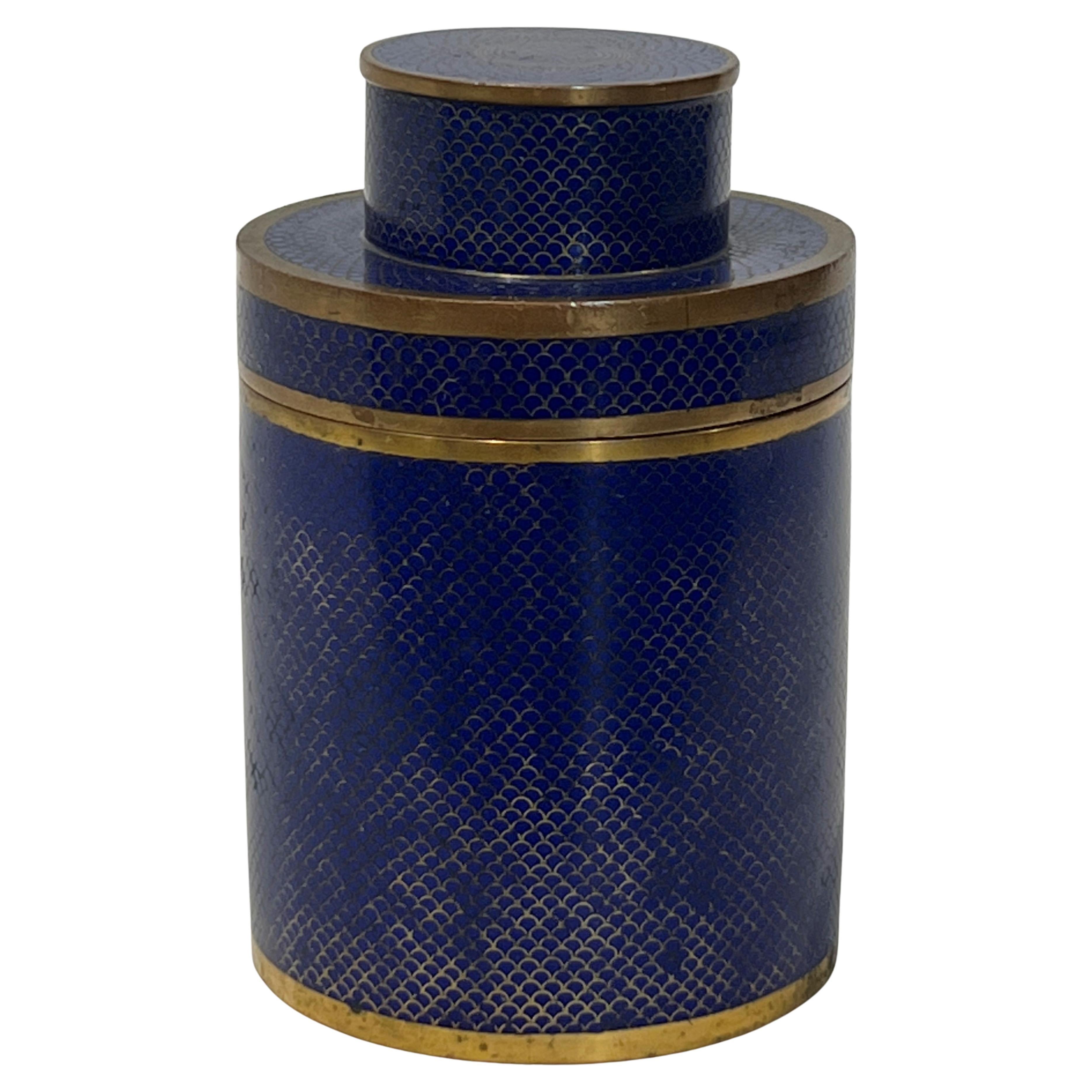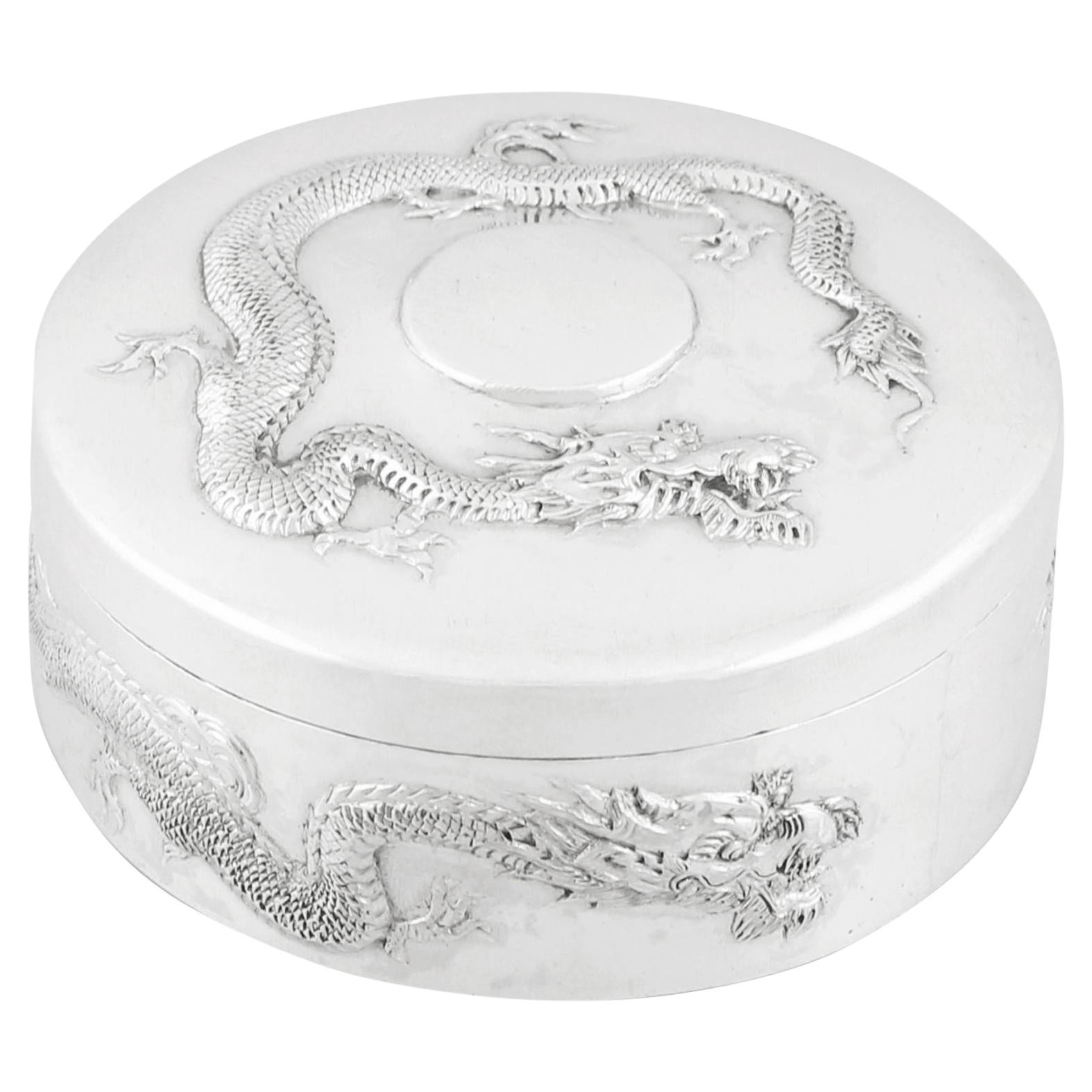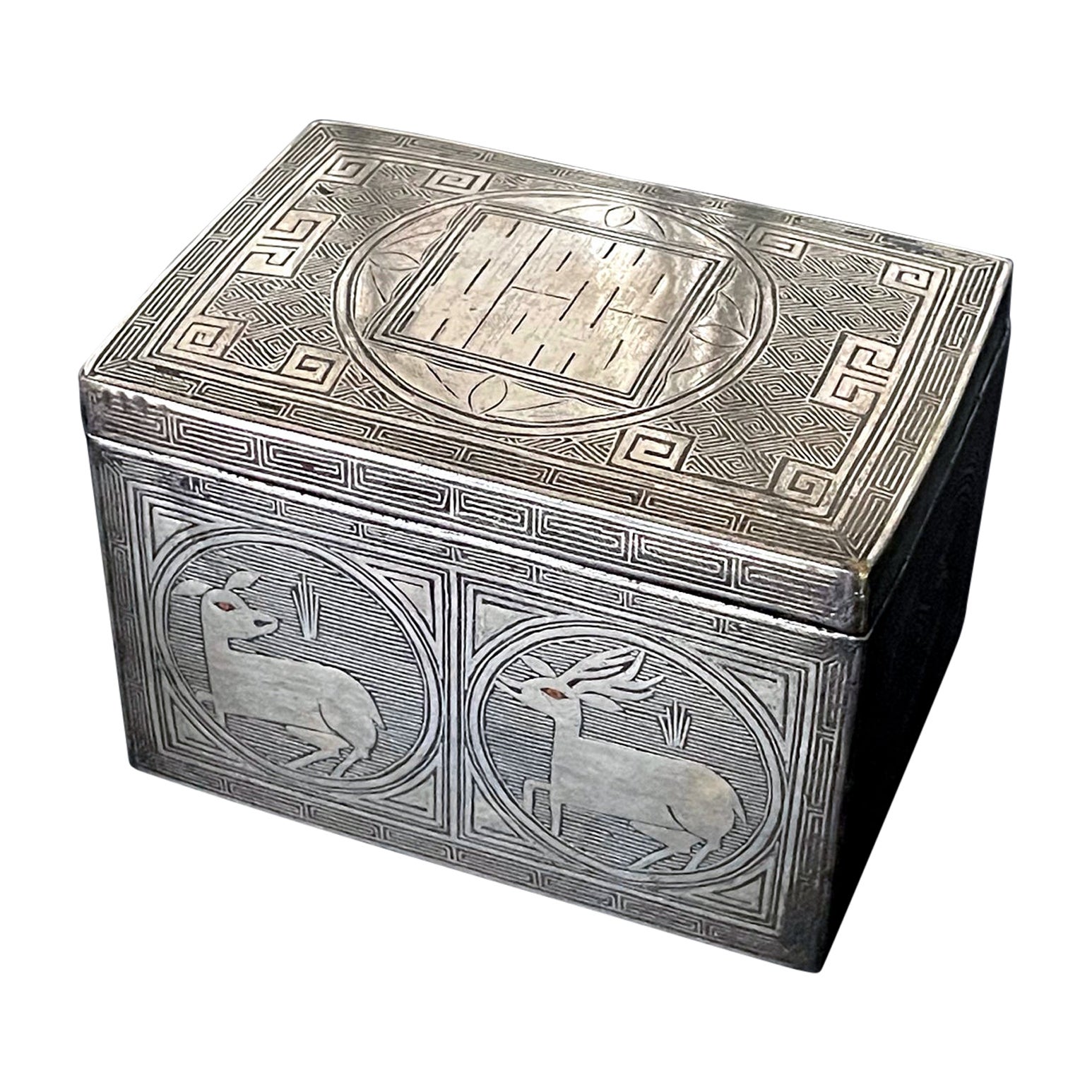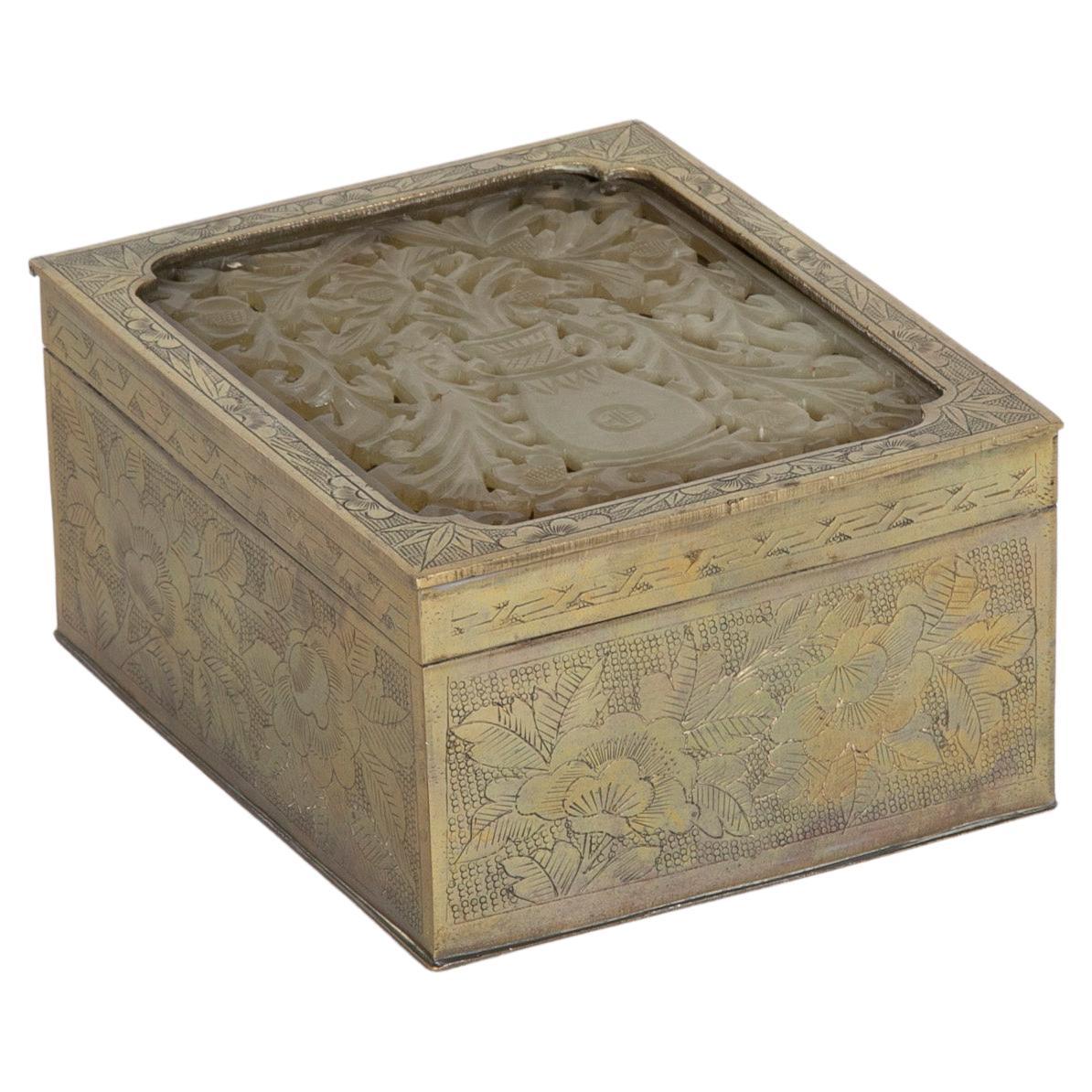Items Similar to Rare Chinese Tonkin Ware Shakudo Sawasa Erotic Tobacco Box
Want more images or videos?
Request additional images or videos from the seller
1 of 3
Rare Chinese Tonkin Ware Shakudo Sawasa Erotic Tobacco Box
About the Item
A ruyi-shaped Shakudo-style erotic tobacco or snuff box, relief-decorated with silvered applied figures
Possibly Jakarta (Batavia), first half 18th century
Measures: H. 2.2 x L. 12.1 x W. 8 cm
This box is very much in the Dutch taste, for the illustration is after a print with a legend reading “L’oiseau sans cage. Prenez, belle, mon oiseau. C’est le plus doux présent que je puisse vous faire. Pour les autres oiseaux, la cage d’ordinaire est une espèce de tombeau. Mais le mien semble prendre une nouvelle vie, Lorsqu’il sera dans la cage de mon aimable Silvie.” The erotic message is as clear as can be.
In Dutch culture the verb ‘vogelen’ (catching a bird) is another word for having sex and a bird escaping from his cage indicates loss of chastity. The lady with the bare breasts, while making the sign of sealed lips to the lady behind her, who is pointing towards heaven, seems to be caressing the bird held in the sleeping man’s groin. 17th century Dutch pictures and poetry are full of birds, and also dogs, with suggestive erotic meanings and the illustration on the present box certainly fits perfectly in this tradition.
The shakudo-style of the box and the Dutch design decoration suggests that either Nagasaki or Batavia might be the place where this box was made for a Dutch client, either by Chinese or by Japanese craftsmen. When Japan closed itself off from the rest of the world in about 1640, the Japanese were not only prohibited from leaving the country but also Japanese abroad were forbidden to return. Some Japanese craftsmen remained outside Japan, in China,
Tonkin and Batavia where they possibly continued to perform their ‘shakudo’ Japanese crafts, called ‘sawasa’ in Batavia. However, the ubiquitous Chinese certainly also mastered this technique.
A similar box was auctioned at Bonhams Hong Kong, 24 November 2013, lot 6, in the sale of the ‘Speelman Collection of Imperial Tribute Snuff Boxes’. This box also has several erotic references; a European lady wearing loose clothing, with an exotic bird perched on her left hand, a man peeping and in the background a farmer spreading seedlings. The inside of the lid bearing a scene of two figures indulged in passionate kissing, flanked by a pair of doves. Surely, a Dutchman having a little tobacco or snuff with his friends, chuckled at this very erotic, though prudish, imagery.
- Dimensions:Height: 0.87 in (2.2 cm)Width: 4.77 in (12.1 cm)Depth: 3.15 in (8 cm)
- Style:Chinese Export (Of the Period)
- Materials and Techniques:
- Place of Origin:
- Period:
- Date of Manufacture:1700-1750
- Condition:Wear consistent with age and use.
- Seller Location:Amsterdam, NL
- Reference Number:1stDibs: LU5458222093022
About the Seller
5.0
Vetted Seller
These experienced sellers undergo a comprehensive evaluation by our team of in-house experts.
Established in 1985
1stDibs seller since 2020
19 sales on 1stDibs
Typical response time: 2 hours
- ShippingRetrieving quote...Ships From: Amsterdam, Netherlands
- Return PolicyA return for this item may be initiated within 7 days of delivery.
More From This SellerView All
- Rare Chinese Tonkin Ware Cup-and-Saucer, Early 18th CenturyLocated in Amsterdam, NLA Chinese made tonkin ware gilt- and lacquer cup and saucer China or Japan, Chinese artisans, early 18th century The black-lacquered cup with gilt handles in the shape of sculptured chrysanthemums and a lobbed edge decorated with gilt engraved border, with a gilt foot-ring that fits into the saucer ring, with two cartouches showing partly undercut gilt relief trees and birds on a gilt granulated background, black lacquered bracket-lobed edge, depicting gilt engraved peony scrolls and three cartouches decorated with high relief gilt trees and birds on a gilt granulated background, the centre with engraved chrysanthemum, enclosed by a raised ring upon which the cup fits, around which a circular panel decorated with high gilt relief trees, flowers, birds and a butterfly on a gilt granulated background. Measures: Cup: H. 5.7 x W. 8.5 cm Saucer: Diameter 13 cm Provenance: Collection Felix Schäfer Note: The decoration of the cup and saucer is identical to the slightly smaller cup and saucer...Category
Antique Early 18th Century Chinese Chinese Export Metalwork
MaterialsOther
- Fine Indian Silver Filigree Casket with Hinged Cover, 18th CenturyLocated in Amsterdam, NLA pair of very fine silver filigree rosewater sprinklers Possibly India, Karimnagar, early 18th century Measures: Height 31.6 cm and 31.7 cm,...Category
Antique 18th Century Indian Metalwork
MaterialsSilver
- Two Palembang Peranakan Lacquerware Bridal Boxes and a TrayLocated in Amsterdam, NLTwo Palembang Peranakan lacquerware bridal boxes and a tray South Sumatra, Palembang, lacquer work by Chinese Peranakan artisans, mid 20th century Woo...Category
Vintage 1950s Indonesian Decorative Boxes
MaterialsWood, Lacquer
- A rare Indonesian tortoiseshell sirih casket with gold mountsLocated in Amsterdam, NLBatavia (Jakarta), 19th century, apparently unmarked H. 5 x W. 18 x D. 13 cm Before settling down to business in the former Dutch East Indies, sirih had to be offered in the most e...Category
Antique 19th Century Indonesian Jewelry Boxes
MaterialsGold
- Japanese Nagasaki Export Lacquer Box with Depiction of the 'Trippenhuis'Located in Amsterdam, NLA Japanese Nagasaki export lacquer box with mother-of-pearl depiction of the Amsterdam ‘Trippenhuis’ Edo-period, circa 1830 H. 12.5 x W. 24 x D. 15 cm ? The house depicted on t...Category
Antique 19th Century Japanese Edo Lacquer
MaterialsMother-of-Pearl, Lacquer
- Dutch Colonial Silver Dish with the Von Pfeffel Coat-of-arms, 17th CenturyLocated in Amsterdam, NLAn unusual Indonesian lobbed silver dish Jakarta (Batavia) or Coromandel coast, third quarter 17th century, apparently unmarked The eight lobbed dish exuberantly decorated with floral motifs, with the middle section replaced, consisting of indistinctly marked German silver from the early 19th century, bearing the coat-of-arms of the Von Pfeffel family. Diam. 30.5 cm Weight 461 grams Note: Lobbed silver dishes with exuberant floral decorations were characteristic of the decorative arts in the Netherlands in the first half of the 17th century. This style of floral decoration was adopted by silversmiths as well as by furniture makers working on the Coromandel Coast and in Batavia, often by workers who had fled the Coromandel Coast because of war and famine. In Batavia this style was known as “Custwerck” (work from the Bengal coast). These lobbed dishes are seldom marked. Only after 1667 the use of the town mark became obligatory in Batavia but only for silver made in Batavia not for silver imported in Batavia from other VOC settlements. The engraved coat of arms in the centre is a replacement of the original centre. The coat of arms can be identified as those of Christian Hubert von Pfeffel (1765- 1834). As a diplomat, statesman, ambassador of Bavaria in London and Saxony and councillor to the King of Bavaria, he was made “Freiherr” in 1828 and since then used this coat of arms. His son Karl Maximilian Friederich Hubert Freiherr von Pfeffel (1811-1890) in 1836 married Karoline Adelheid Pauline von Rottenburg (1805-1872), the natural daughter of Prins Paul von Württemberg (1785-1852) and his mistress Margrethe Porth. Paul was the jounger brother of the King Wilhelm I of Württemberg (1781-1864). The heraldic motto of the von Pfeffels Vur Schande habe den Huot means as much as “Beware of Shame”. Christian Hubert Theodoor Marie Karl von Pfeffel Karl Maximilian’s grandson was the last male in the von Pfeffel line. His daughter, Marie Louise (Paris in 1882 - Cornwall 1944), born and grown-up in France, changed her name in de Pfeffel. She was the great grandmother of Boris Alexander de Pfeffel Johnson, the present British Secretary of State. None of the members of the von Pfeffel family had any direct links with the Dutch East Indies but indirectly by way of the Royal House of Württemberg they did. Sophia Frederika Mathilda von Württemberg (1818-1877), daughter of Wilhelm I King of Württemberg, in 1839 married Willem III...Category
Antique Late 17th Century Indonesian Dutch Colonial Sterling Silver
MaterialsSilver
You May Also Like
- Fish Scale Midnight Blue Chinese Cloisonne Tobacco Box 1930'sLocated in Mobile, ALMonochrome Chinese Fish Scale cloisonne is long famed for it's high quality of craftsmanship and understated elegance. A staple of interior design...Category
Vintage 1930s Chinese Chinoiserie Metalwork
MaterialsMetal, Enamel
- Signed Japanese Steel Shakudo Damascene Box with a Shimazu MonLocated in Philadelphia, PAA fine antique 20th century Japanese Amita Damascene Steel Box. Made of damascened steel inlaid with gold & silver. The lid of the box has gilt depictions of bamboo plants, whi...Category
20th Century Japanese Showa Metalwork
MaterialsGold, Silver, Copper, Steel
- Antique Chinese Export Silver Box by Wang HingBy Wang Hing & Co.Located in Jesmond, Newcastle Upon TyneAn exceptional, fine and impressive antique Chinese export silver dragon box; an addition to our collection of boxes and cases This fine antique C...Category
Antique 19th Century Chinese Chinese Export Decorative Boxes
MaterialsSilver
- Fine Korean Iron Tobacco Box with Silver Inlay Joseon DynastyLocated in Atlanta, GAA fine Korean iron box used to store tobacco leaves dated to the late Joseon Dynasty circa 19th century. The box is made from iron and has a heavy weight, although the wears along the edges of the lid and base exposes a bronze metal color underneath, indicating the iron metal may contains a high level of copper. The surface was beautifully decorated with elaborate silver inlay that covers the entire surface except the base. The extraordinary workmanship depicts a pair of deer within the circled square (shape of heaven and earth) and a lined background on the long sides and a crane with spread wings on the shorter sides. Both animals were associated with longevity. Their eyes were highlighted with copper inlay, adding a lively touch to the animation. The lid is centered with a Chinese character "Xi" (Paired-Hui in Korean), which means double happiness. (In Chinese culture, it is often used in a wedding ceremony). The large symbol was set on geometrical background of tightly scrolling diamond pattern surrounded by stylized Ruyi mushroom heads, another floral longevity symbol. Archaic fret cloud band borders the entire perimeters of the lid and the container. Tobacco was introduced to Korean in the first half of the 17th century and gradually gained popularity. When the tobacco was started being smoked in shredded form instead of rolled leaves, there rose the production of the smoking accessories, with some in fine quality as luxury items for the elite. The accoutrement such as this box is a fine example made in late Joseon dynasty, using extensive silver inlay, a technique called "jjoeum-ipsa", in which the silver wires were hammered into the scorched iron surface to create the elaborate design. Similar boxes with variation of shape and motifs are in the collection of several major museums. Compare the box with item Gu 754 in the National Museum of Korea; item 22.78 in MET NYC and M.240:1, 2-1926 in V& A Museum in London. The most closely related example we found is item C232 in the collection of the Museum of East Asian Art...Category
Antique 19th Century Korean Other Metalwork
MaterialsSilver, Copper, Iron
- Chinese Etched Brass Box with Carved Jade Inset Top, Circa 1900Located in Stamford, CTSweet little Chinese export brass box with beautiful floral etched designs, looks like peonies to me. With a lovely white jade top carved in fretwork with a vase framed by the flower...Category
Early 20th Century Chinese Chinese Export Decorative Boxes
MaterialsJade, Brass
- Chinese Lattice Top Incense Box, c. 1850Located in Chicago, ILThis slender metal container is a 19th-century white brass incense burner, used for storing and burning incense sticks. The small box has a rectangular form and a removable sliding t...Category
Antique Mid-19th Century Chinese Qing Metalwork
MaterialsBrass





